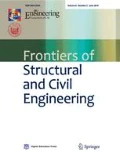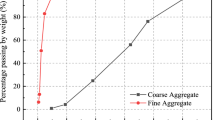Abstract
In this study, ultrahigh-performance fiber-reinforced concrete (UHPFRC) used in a type B70 concrete sleeper is investigated experimentally and parametrically. The main parameters investigated are the steel fiber volume fractions (0%, 0.5%, 1%, and 1.5%). Under European standards, 35 UHPFRC sleepers are subjected to static bending tests at the center and rail seat sections, and the screw on the fastening system is pulled out. The first cracking load, failure load, failure mode, crack propagation, load-deflection curve, load-crack width, and failure load from these tests are measured and compared with those of a control sleeper manufactured using normal concrete C50. The accuracy of the parametric study is verified experimentally. Subsequently, the results of the study are applied to UHPFRC sleepers with different concrete volumes to investigate the effects of the properties of UHPFRC on their performance. Experimental and parametric study results show that the behavior of UHPFRC sleepers improves significantly when the amount of steel fiber in the mix is increased. Sleepers manufactured using UHPFRC with a steel fiber volume fraction of 1% and a concrete volume less than 25% that of standard sleeper B70 can be used under the same loads and requirements, which contributes positively to the cost and surrounding environment.
Similar content being viewed by others
References
Tolou Kian A R, Sadeghi J, Zakeri J A. Influences of railway ballast sand contamination on loading pattern of pre-stressed concrete sleeper. Construction & Building Materials, 2020, 233: 117324
Berbey Alvarez A, Guevara-Cedevo J. Railway Engineering. Oxford: Oxford University Press, 2021, 371–395
Sadeghi J, Barati P. Comparisons of the mechanical properties of timber, steel and concrete sleepers. Structure and Infrastructure Engineering, 2010, 8: 1151–1159
Bae Y, Pyo S. Effect of steel fiber content on structural and electrical properties of ultra high performance concrete (UHPC) sleepers. Engineering Structures, 2020, 222: 111131
Remennikov A M, Murray M H, Kaewunruen S. Conversion of AS1085. 14 for prestressed concrete sleepers to limit states design format. In: AusRAIL PLUS 2007 Conference & Exhibition. Sydney: Australian Railway Association (ARA), 2007, 1–18
Lutch R H. Capacity optimization of a prestressed concrete railroad tie. Thesis for the Master’s Degree. Houghton, MI: Michigan Technological University, 2009
Sadeghi J M, Babaee A. Structural optimization of B70 railway prestressed concrete sleepers. Iranian Journal of Science & Technology, Transaction B, Engineering, 2006, 30(B4): 461–473
Kaewunruen S, Remennikov A M. Progressive failure of prestressed concrete sleepers under multiple high-intensity impact loads. Engineering Structures, 2009, 31(10): 2460–2473
Kaewunruen S, Remennikov A M. Dynamic crack propagations in prestressed concrete sleepers in railway track systems subjected to severe impact loads. Journal of Structural Engineering, 2010, 136(6): 749–754
Vairagade V S, Kene K S, Patil T R. Comparative study of steel fiber reinforced over control concrete. International Journal of Scientific and Research Publications, 2012, 2(5): 1–3
Yazıcı Ş, Inan G, Tabak V. Effect of aspect ratio and volume fraction of steel fiber on the mechanical properties of SFRC. Construction & Building Materials, 2007, 21(6): 1250–1253
Wu Z, Shi C, He W, Wu L. Effects of steel fiber content and shape on mechanical properties of ultra high performance concrete. Construction & Building Materials, 2016, 103: 8–14
Beglarigale A, Yazici H. Pull-out behavior of steel fiber embedded in flowable RPC and ordinary mortar. Construction & Building Materials, 2015, 75: 255–265
Mahakavi P, Chithra R. Impact resistance, microstructures and digital image processing on self-compacting concrete with hooked end and crimped steel fiber. Construction & Building Materials, 2019, 220: 651–666
Abousnina R, Premasiri S, Anise V, Lokuge W, Vimonsatit V, Ferdous W, Alajarmeh O. Mechanical properties of macro polypropylene fibre-reinforced concrete. Polymers, 2021, 13(23): 1–25
Yu P, Manalo A, Ferdous W, Abousnina R, Salih C, Heyer T, Schubel P. Investigation on the physical, mechanical and microstructural properties of epoxy polymer matrix with crumb rubber and short fibres for composite railway sleepers. Construction & Building Materials, 2021, 295: 123700
Li L, Wang B, Hubler M H. Carbon nanofibers (CNFs) dispersed in ultra-high performance concrete (UHPC): Mechanical property, workability and permeability investigation. Cement and Concrete Composites, 2022, 131: 104592
Pyo S, Kim H K, Lee B Y. Effects of coarser fine aggregate on tensile properties of ultra high performance concrete. Cement and Concrete Composites, 2017, 84: 28–35
Schmidt M, Fehling E, Geisenhanslüke C. Ultra High Performance Concrete (UHPC): Proceedings of the International Symposium on Ultra High Performance Concrete. Kassel: Kassel University Press, 2004
ACI 239R-18. Ultra-High-Performance Concrete: An Emerging Technology Report. Farmington Hills, MI: American Concrete Institute, 2018
Safdar M, Matsumoto T, Kakuma K. Flexural behavior of reinforced concrete beams repaired with ultra-high performance fiber reinforced concrete (UHPFRC). Composite Structures, 2016, 157: 448–460
Yoo D Y, Jang Y S, Chun B, Kim S. Chelate effect on fiber surface morphology and its benefits on pullout and tensile behaviors of ultra-high-performance concrete. Cement and Concrete Composites, 2021, 115: 103864
Lam N N, Van Hung L. Mechanical and shrinkage behavior of basalt fiber reinforced ultra-high-performance concrete. GEOMATE Journal, 2021, 20(78): 28–35
Bae Y, Pyo S. Ultra high performance concrete (UHPC) sleeper: Structural design and performance. Engineering Structures, 2020, 210: 110374
EN 13230-6. Railway Applications-Track-Concrete Sleepers and Bearers—Part 6: Design. Brussles: European Committee for Standardization (CEN), 2014
EN 13230-2. Railway Applications-Track-Concrete Sleepers and Bearers—Part 2: Prestressed Monoblock Sleepers. Brussles: European Committee for Standardization (CEN), 2009
EN 13481-2. Railway applications-Track-Performance Requirements for Fastening Systems—Part 2: Fastening Systems for Concrete Sleepers. Brussles: European Committee for Standardization (CEN), 2014
EN 10138-2. Prestressing Steels—Part 2: Wire Armatures. Brussles: European Committee for Standardization (CEN), 2000
Yu R, Spiesz P, Brouwers H J H. Mix design and properties assessment of ultra-high performance fibre reinforced concrete (UHPFRC). Cement and Concrete Research, 2014, 56: 29–39
Pyo S, Wille K, El-Tawil S, Naaman A E. Strain rate dependent properties of ultra high performance fiber reinforced concrete (UHP-FRC) under tension. Cement and Concrete Composites, 2015, 56: 15–24
Mo Z, Gao X, Su A. Mechanical performances and microstructures of metakaolin contained UHPC matrix under steam curing conditions. Construction & Building Materials, 2021, 268: 121112
UIC 713R. Design of Monoblock Concrete Sleepers. Paris: International Union of Railways, 2004, 30
Yang J M, Shin H O, Yoon Y S, Mitchell D. Benefits of blast furnace slag and steel fibers on the static and fatigue performance of prestressed concrete sleepers. Engineering Structures, 2017, 134: 317–333
Yoo D Y, Lee J Y, Shin H O, Yang J M, Yoon Y S. Effects of blast furnace slag and steel fiber on the impact resistance of railway prestressed concrete sleepers. Cement and Concrete Composites, 2019, 99: 151–164
ACI 544.4R-88. Design Considerations for Steel Fiber Reinforced Concrete. Farmington Hills, MI: American Concrete Institute, 1999
Acknowledgements
We thank the National Authority for Tunnels for allowing us to use the Siegwart factory to fabricate our specimens. The authors appreciate the support provided by members of the Housing and Building National Research Center, Egypt.
Author information
Authors and Affiliations
Corresponding author
Rights and permissions
About this article
Cite this article
Ahmed, S., Atef, H. & Husain, M. Experimental and parametrical investigation of pre-stressed ultrahigh-performance fiber-reinforced concrete railway sleepers. Front. Struct. Civ. Eng. 17, 411–428 (2023). https://doi.org/10.1007/s11709-023-0928-3
Received:
Accepted:
Published:
Issue Date:
DOI: https://doi.org/10.1007/s11709-023-0928-3




